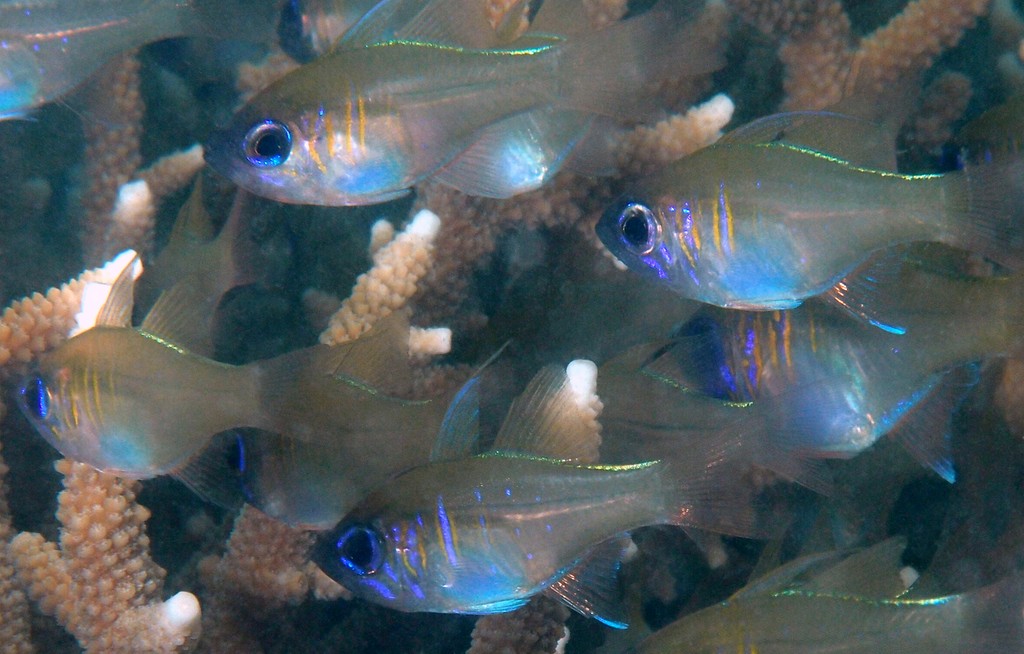ZORAMIA LEPTACANTHA - (BLEEKER, 1856)
Actinopterygii (Gigaclass) > Actinopteri (Class) > Teleostei (Subclass) > Gobiiformes (Order) > Apogonoidei (Suborder) > Apogonidae (Family) > Apogoninae (Subfamily) > Zoramia (Genus)
Apogon à dorsale filamenteuse, Apogon à rayures bleues, Threadfin cardinalfish, Long-spine cardinal, Long-spine cardinalfish, Longspine cardinalfish, Bluestreak cardinalfish, Langstekel-kardinaal, Itohiki-tenjikudai,
Synonymes
Amia nematacantha (Ogilby, 1913)
Apogon arenatus (Bleeker, 1859-60)
Apogon graeffii (Günther, 1873)
Apogon leptacanthus (Bleeker, 1856)
Zoramia leptacanthus (Bleeker, 1856)
---------------------------------------------
Description
Dorsal spines (total): 7; Dorsal soft rays (total): 9; Anal spines: 2; Anal soft rays: 9. Semi-transparent to whitish in color with blue spots and incomplete, narrow, orange bars on head and anterior part of body. Tall first dorsal fin, eyes blue. Elongate first dorsal fin; greatest depth of body 2.1-2.6 in SL. Max length : 6.0 cm TL. Depth range 1 - 12 m.
Color
In alcohol: body pale with dusky line along base of dorsal fins and mid-dorsally on caudal peduncle; peritoneum with small dark spots; digestive tract black.
In life: translucent grey, silvery over lower head and body, with vertical yellow and blue lines on postorbital head and anterior body, and few scattered small blue spots on body; iridescent pale blue line at base of dorsal fins and dorsally on caudal peduncle.
Etymology
Zoramia: etymology not explained, perhaps from Greek, zoros = sheer, pure + from Greek, amia, -as = a kind of bonito. Name given by Aristotle to a fish (Later name applied to Apogon by Gronow (1763), now a commonly used suffix in the family). Referring to their partial transparency.
Distribution
Indo-Pacific: Red Sea and Mozambique Island to Samoa and Tonga, north to Ryukyu Islands, south to New Caledonia; throughout Micronesia.
Biology
Dense aggregations (often mixed with other species, like Archamia fucata (Cantor, 1849), Archamia zosterophora (Bleeker, 1856) are found above mounds of branching corals Porites cylindrica (Dana, 1846) in sheltered, often turbid bays and lagoons. Nocturnal species. At night, when it is actively feeding on zooplankton, it loses the blue and yellow markings. Mouthbrooders. Distinct pairing during courtship and spawning.
Apogon à dorsale filamenteuse, Apogon à rayures bleues, Threadfin cardinalfish, Long-spine cardinal, Long-spine cardinalfish, Longspine cardinalfish, Bluestreak cardinalfish, Langstekel-kardinaal, Itohiki-tenjikudai,
Synonymes
Amia nematacantha (Ogilby, 1913)
Apogon arenatus (Bleeker, 1859-60)
Apogon graeffii (Günther, 1873)
Apogon leptacanthus (Bleeker, 1856)
Zoramia leptacanthus (Bleeker, 1856)
---------------------------------------------
Description
Dorsal spines (total): 7; Dorsal soft rays (total): 9; Anal spines: 2; Anal soft rays: 9. Semi-transparent to whitish in color with blue spots and incomplete, narrow, orange bars on head and anterior part of body. Tall first dorsal fin, eyes blue. Elongate first dorsal fin; greatest depth of body 2.1-2.6 in SL. Max length : 6.0 cm TL. Depth range 1 - 12 m.
Color
In alcohol: body pale with dusky line along base of dorsal fins and mid-dorsally on caudal peduncle; peritoneum with small dark spots; digestive tract black.
In life: translucent grey, silvery over lower head and body, with vertical yellow and blue lines on postorbital head and anterior body, and few scattered small blue spots on body; iridescent pale blue line at base of dorsal fins and dorsally on caudal peduncle.
Etymology
Zoramia: etymology not explained, perhaps from Greek, zoros = sheer, pure + from Greek, amia, -as = a kind of bonito. Name given by Aristotle to a fish (Later name applied to Apogon by Gronow (1763), now a commonly used suffix in the family). Referring to their partial transparency.
Distribution
Indo-Pacific: Red Sea and Mozambique Island to Samoa and Tonga, north to Ryukyu Islands, south to New Caledonia; throughout Micronesia.
Biology
Dense aggregations (often mixed with other species, like Archamia fucata (Cantor, 1849), Archamia zosterophora (Bleeker, 1856) are found above mounds of branching corals Porites cylindrica (Dana, 1846) in sheltered, often turbid bays and lagoons. Nocturnal species. At night, when it is actively feeding on zooplankton, it loses the blue and yellow markings. Mouthbrooders. Distinct pairing during courtship and spawning.
